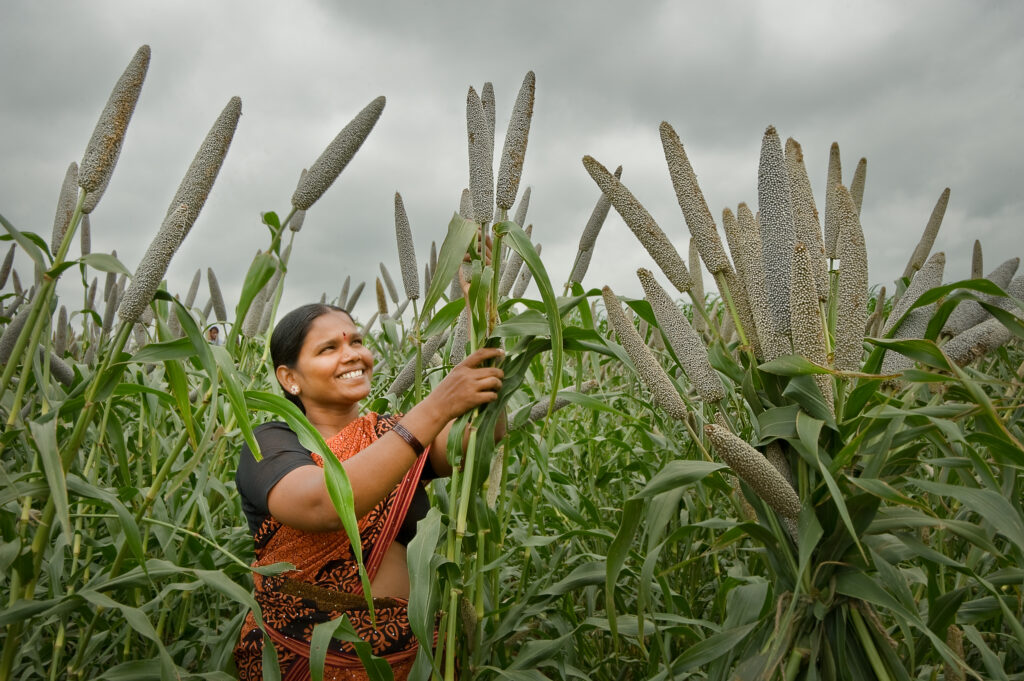India leads in prioritizing nutrition in breeding
The Indian Council of Agricultural Research (ICAR) has established minimum levels of iron and zinc to be bred into national varieties of pearl millet. The news comes during the National Year of Millets and as the government of India articulates its vision for a Kuposhan Mukt Bharat (Malnutrition Free India) by 2022. In India, 59 percent of children under five and 54 percent of pregnant women are anemic, while 38 percent of children in the same age group are stunted. Diets deficient in iron and zinc are a major cause of anemia and stunting, respectively.
For resource-poor farming families or rural communities who rely on staple crops like pearl millet for much of their diet, nutrient-enriched versions of these crops present a cost-effective, sustainable strategy to improve nutrition. Biofortification, which uses conventional breeding to increase micronutrient levels of food crops, helps address preventable deficiencies of key vitamins and minerals like iron, vitamin A and zinc. This hidden hunger often results from diets lacking in diversity or essential nutrients. The Indian government has therefore committed to reaching vulnerable populations with this agricultural-nutrition innovation. HarvestPlus works with partners to develop and distribute biofortified varieties of these staple crops.
“Including biofortified pearl millet in the Public Distribution System’s mid-day meal scheme for pregnant and lactating women, as well as the Integrated Child Development Services’ school feeding program, will both further trigger the demand for these nutritious grains and improve nutritional outcomes,” says HarvestPlus India Country Manager Mr. Binu Cherian. These distribution channels allow the biofortified iron pearl millet to reach several millions.
Because of its ability to grow well in dry soil, pearl millet is a staple crop for over 90 million people across the world. In India, it is consumed by households primarily in the form of breads and porridges. About 9 million hectares of Indian farmland is dedicated to pearl millet with 8.3 million tons annual production.
The pearl millet biofortification program supported by HarvestPlus researched how iron and zinc levels vary among different varieties. “The International Crops Research Institute for the Semi-Arid Tropics (ICRISAT) has over ten years of experience breeding biofortified varieties of pearl millet,” says breeder and project leader Dr. M. Govindaraj, “and with support from HarvestPlus we have further enhanced the levels of iron in our varieties.” In a nutrition efficacy study, eating biofortified pearl millet resolved iron deficiency in 65 percent of school-aged children after only six months. It also improved their cognitive abilities such as memory and attention, skills essential for optimal performance at school.
To improve varieties released, the All-India Coordinated Research Project on Pearl Millet (ICAR-AICRP on Pearl Millet) encouraged National Agricultural Research Systems to begin breeding programs for micronutrients along with higher yields in 2014. Since then, three biofortified hybrids and varieties including Dhanashakti have been released and adopted in India, while three more hybrids were identified for imminent release. In 2016, ICRISAT and ICAR-AICRP-Pearl Millet jointly published the status of iron and zinc content among released hybrids in India. “Based on this evidence, at the 52nd Annual Meeting of the Pearl Millet Improvement Project in 2017, it was agreed that all pearl millet varieties would be bred to contain a minimum 42 ppm of iron and 32 ppm of zinc,” says Dr C. Tara Satyavathi, Coordinator of ICAR-AICRP on Pearl Millet.
“This commitment will further strengthen the biofortification program and accelerate product development in India, to improve the nutritional status of poor households,” says Dr. Wolfgang Pfeiffer, director of research and development at HarvestPlus.
This activity was carried out as part of the CGIAR Research Program Agriculture for Nutrition and Health (A4NH) and the CGIAR Research Program on Grain Legumes and Dryland Cereals (GLDC).
